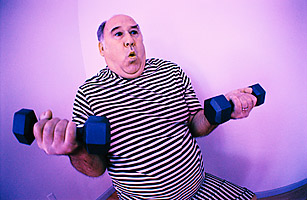
Some families, alas, are fatter than others. But for dieters continually at war with their genes, there’s good news in a study published in this week’s PLoS Medicine: they can burn off 40% of their genetic predisposition to obesity by exercising.
Led by Dr. Ruth Loos from the Medical Research Council Epidemiology Unit in Cambridge, U.K., the study evaluated more than 20,000 Britons aged 39 to 79, asking about their exercise habits and surveying their genes. Researchers focused on 12 genetic variants known to increase the risk of obesity, and calculated a genetic obesity-predisposition score for each individual based on how many variants the person had.
Researchers then compared the volunteers’ scores with their body mass index , the commonly used ratio of height and weight that defines obesity, and further examined the impact of exercise on BMI. Unlike many past studies that have only zeroed in on variants of one gene, the well-known FTO obesity gene, the new result is a more complete picture of how physical activity affects a person’s susceptibility to obesity — and one that offers reason for hope.
For a 5-ft. 7-in. person, the study found, each additional genetic variant inherited from either parent led to an extra pound of weight on average, compared with people with no genetic predisposition to obesity. Here’s the good news: the more active the person was, the smaller the weight gain. The avowed couch potatoes in the study, who reported working a sedentary job and engaging in zero recreational physical activity, weighed the equivalent of an extra 1.3 lb. per variant. “Moderately inactive” people — those who worked at a standing job or reported less than 30 minutes a day of recreational activity on top of a sedentary lifestyle — were comparatively less overweight, logging an extra 0.87 lb. per variant.
Moderately active people — those who combined a sedentary job with 30 to 60 minutes a day of physical activity, or had a standing job with less than half an hour a day of exercise — gained even less, with each variant translating to an extra 0.85 lb. . And active people — those exercising more than an hour a day outside their sedentary job, say, or working in heavy manual labor — were thinnest, gaining an extra 0.8 lb. per variant, a full 36% less than their least active peers. Overall, by exercising they had reduced their genetic risk of obesity by 40% compared with their inactive peers.
Not surprisingly, a similar relationship between physical activity and obesity risk held for people who were not genetically predisposed to be heavy. But the exercise effect was smaller: regardless of size, a person wired to be heavy will reduce his or her odds of obesity more through physical activity than a person who’s genetically lean. In other words, not only can those wired big benefit from exercise, but also they can actually benefit more by working out than their counterparts with the right genes for skinny jeans.
Scientists hope the findings could pave the way for personalized obesity treatments in the future.
Unlike some past research — such as a 2008 study of about 700 Amish people that found it may take a punishing three to four hours a day of exercise to whip your genes into shape — the new paper suggests that even little boosts can make a big difference in overcoming your genetic makeup. “You don’t have to run marathons,” says Dr. Loos. “It is sufficient to do some physical activity.”
The authors speculate that the differences in results could be due to characteristics specific to the populations in past studies or the small sample sizes in previous research. The strengths of Loos’ study include its range of included genetic variants and its large sample size. But there is also a notable weakness: the fact that participants were required to self-report their exercise habits rather than actually be observed on the Stairmaster by scientists.
Still, with the number of obese adults worldwide expected to bloat to 700 million by 2015, any suggestion that we can overcome our genes and whittle our waistlines is welcome news.
See how to prevent illness at any age.
See the top 10 medical breakthroughs of 2009.